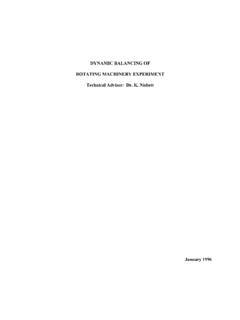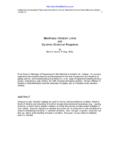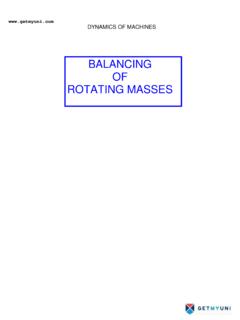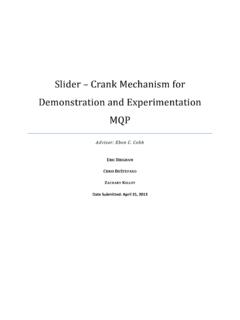Transcription of 5 NOISE SOURCES - World Health Organization
1 5 NOISE SOURCESP rofessor Samir GergesGustav A. Sehrndt* and Wolfgang PartheyFederal University of Santa CatarinaFederal Institute for OccupationalMechanical Engineering Department Safety and HealthNoise and Vibration LaboratoryFriedrich-Henkel-Weg - Florian polis - SC44149 INTRODUCTIONI ndustrial machinery and processes are composed of various NOISE SOURCES such as rotors, stators,gears, fans, vibrating panels, turbulent fluid flow, impact processes, electrical machines, internalcombustion engines etc. The mechanisms of NOISE generation depend on the particularly noisyoperations and equipment including crushing, riveting, blasting (quarries and mines), shake-out(foundries), punch presses, drop forges, drilling, lathes, pneumatic equipment ( jack hammers,chipping hammers, etc.)
2 , tumbling barrels, plasma jets, cutting torches, sandblasting, electricfurnaces, boiler making, machine tools for forming, dividing and metal cutting, such as punching,pressing and shearing, lathes, milling machines and grinders, as well as textile machines, beveragefilling machines and print machines, pumps and compressors, drive units, hand-guided machines,self-propelled working machines, in-plant conveying systems and transport vehicles. On top of thisthere are the information technology devices which are being encountered more and more in allareas. NOISE is therefore a common occupational hazard in a large number of workplaces such as theiron and steel industry, foundries, saw mills, textile mills, airports and aircraft maintenance shops,crushing mills, among many others.
3 In many countries, NOISE -induced hearing loss is one of themost prevalent occupational diseases. According to a Environmental Protection Agency(EPA)/USA report in 1981, there are more than nine million Americans exposed to a daily averageoccupational NOISE level above 85 dB(A); this number has increased to about 30 million in of these workers are in the production and manufacturing industries (see Table ).Studies in Germany and other industrialized countries have shown that the proportion of thoseexposed to daily average NOISE levels above 85 dB(A) can generally be taken as 12 % to 15% of allemployed persons; that is 4 to 5 million persons in Germany (Pfeiffer 1992). After many years ofexposure to NOISE , there are numerous cases of occupationally related hearing damage recognized_____* Present address: Gustav A.
4 Sehrndt, NOISE Control ConsultantNiesertstr. 4248145 Muenster, sourcesTable Workers exposed to daily LAeq exceeding 85 dB(A).(EPA, 1981)Agriculture323000 Mining400000 Construction513000 Manufacturing andUtilities5124000 Transportation1934000 Military976000 Total9270000as the occupational disease " NOISE -related hearing impairment" according to the OccupationalDiseases Ordinance. An acquired NOISE -related hearing impairment which leads to a reductionin earning ability of 20 % and more is compensated for in Germany in the form of a shows the high percentages of those with impaired hearing due to NOISE in relation toother selected occupational Number and percentages for some selected occupational diseases/disorders in1998 (total in Germany, from BMA, 1999).
5 Cases registered for first timecases recognized for first time without indemnitycases registered& indemnifiedfor first time(reduction of earningability 20%)Occupationaldiseases/disordersnumber %number%number%meniscus from vibrations sourcesA cross-section analysis in Germany of working equipment and processes in operational noiseareas with a hearing impairment hazard has shown that 80 % of the - several million - soundsources can be attributed to machine operations, conveying systems, control and regulationdevices and turbo machines, while 20 % are accounted for by manual working and conveyingoperations. About three quarters of the machine operations can be attributed to machine tools(Damberg, Foss 1982).
6 The main concern of NOISE control is therefore the development,production and preferred use of low- NOISE working equipment and avoidance or minimization of Health hazards in the working process by the appropriatedesign of working equipment and processes, in other words by prevention, has also been elevatedto a principle on an European level. With the establishment of regulations concerning the natureof machines, devices and installations in EU Directives and more specific European standards,it can be assumed that there is a high level of safety, Health and consumer protection. This noisecontrol principle is manifested in the definition and declaration of NOISE characteristics forproducts or machines and the description of achievable values by the INDUSTRIAL NOISE SOURCESIn this section, the fundamental mechanisms of NOISE SOURCES are discussed, as well as someexamples of the most common machines used in the work environment.
7 The sound pressure levelgenerated depends on the type of the NOISE source, distance from the source to the receiver andthe nature of the working environment. For a given machine, the sound pressure levels dependon the part of the total mechanical or electrical energy that is transformed into acoustical fields in the workplace are usually complex, due to the participation of many SOURCES :propagation through air (air-borne NOISE ), propagation through solids (structure-borne NOISE ),diffraction at the machinery boundaries, reflection from the floor, wall, ceiling and machinerysurface, absorption on the surfaces, etc. Therefore any NOISE control measure should be carriedout after a source ranking study, using identification and quantification techniques.
8 The basicmechanism of NOISE generation can be due to mechanical NOISE , fluid NOISE and/orelectromagnetic NOISE (Allen, 1970 and ISO/TR 11688).The driving force for economic development is mainly the endeavour to produce consumergoods ever more cost-effectively. From the point of view of the machine manufacturer, thisgenerally means offering products with a low space, material, energy and production timerequirement (smaller, lighter, more economical and more productive). At the same time accountis being taken increasingly of resource conservation and environmental friendliness, although therise in NOISE levels which frequently goes along with increased output and productivity is oftenoverlooked.
9 Personnel are then exposed to higher NOISE levels than before, despite NOISE -reducingmeasures taken in the machine's design. This is because the NOISE emission rises non-linearlybecause of higher rotary and travelling speeds in machine example, for every doubling of the rotary speed the NOISE emission for rotating printmachines rises by about 7 dB, for warp knitting looms 12 dB, for diesel engines 9 dB, for petrolengines 15 dB and for fans is between 18 to 24 dB. For the purpose of comparison: the doublingof sound power produces an increase in emission of 3 dB even previously quiet procedures are often replaced by loud ones for reasons of cost, vibration instead of annealing for welded parts.
10 In some cases new technologies alsoresult in higher emissions; for example, with the use of phase-sequence-controlled electrical106 NOISE sourcesdrives, the excitation spectrum shifts further to high frequencies, which results in a greater soundradiation from large machine surfaces. This means that some new NOISE problems are closelyrelated to the use of modern Mechanical NOISE A solid vibrating surface, driven or in contact with a prime mover or linkage, radiates soundpower (W in Watts) proportional to the vibrating area S and the mean square vibrating velocity< v 2>, given by; WcSrad= 2where ' is the air density (kg/m3),c is the speed of sound (m/s) and )rad is the radiation efficiency (see Gerges 1992).
















